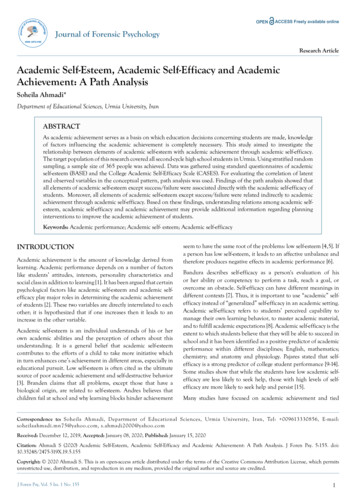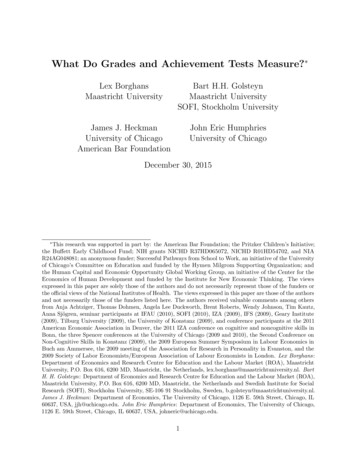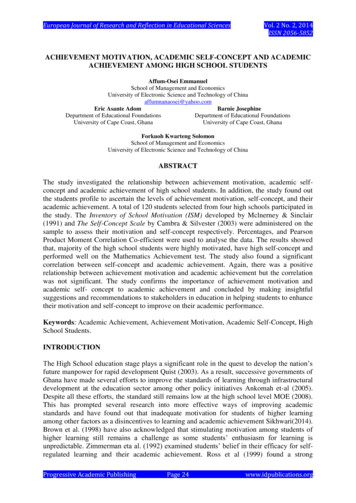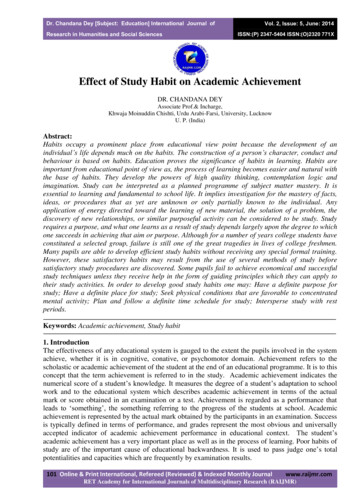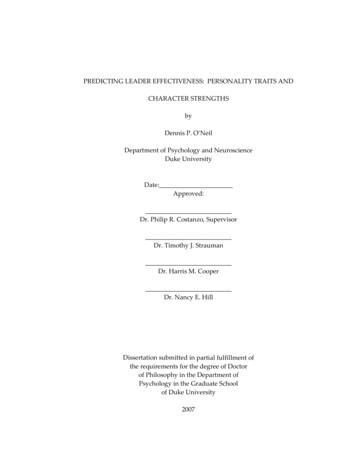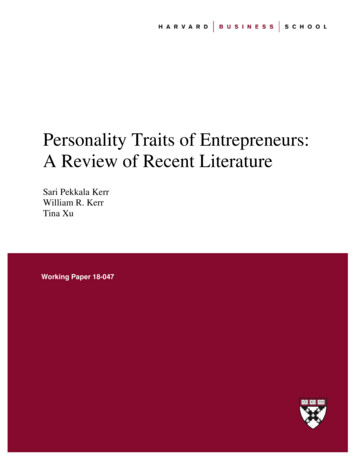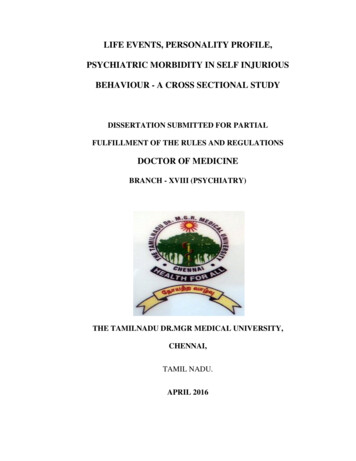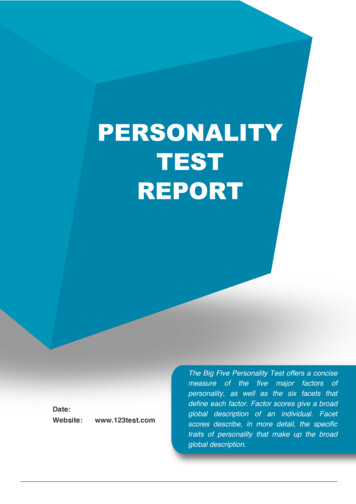
Transcription
ACADEMIC ACHIEVEMENT ANDPERSONALITY TRAITS:An empirical and neurobiologicalinvestigation.Bachelor Degree Project in Cognitive Neuroscience30 ECTSSpring term 2014Helena BjurbergSupervisor: Kristoffer EkmanExaminer: Daniel Broman
Academic Achievement and Personality Traits: An empirical and NeurobiologicalInvestigationSubmitted by Helena Bjurberg to the University of Skövde as a final year project towards thedegree of B.Sc. in the School of Bioscience. The project has been supervised by KristofferEkman.2014-06-10I hereby certify that all material in this final year project which is not my own work has beenidentified and that no work is included for which a degree has already been conferred on me.Signature:
ACADEMIC ACHIEVEMENT, PERSONALITY TRAITS AND THEIR3NEUROBIOLOGYAbstractThe present thesis explores how personality traits are connected to academic achievement.First, a theoretical discussion on the neurobiological basis of different personality traits ispresented, where variance in brain- activity, volume and chemistry describes possibledifferences in personality. Traits previously linked to academic achievement is also describedin terms of neurobiology. This is followed by an empirical investigation of the connectionbetween personality traits and academic achievement. Previous research suggest the Big Five(Costa & McCrae, 1992a) personality traits of conscientiousness, order and self-discipline tobe positively associated with academic achievement. Also, similar suggestions have been putforward concerning the Values in Action (VIA-IS; Peterson & Seligman, 2004) characterstrengths of love of learning, self-regulation and persistence and academic achievement. 90students in a medium sized Swedish senior high school completed the two personalityinventories and their grades were collected. Positive correlations were found for thepersonality traits conscientiousness, order, and self-discipline and for the character strengthspersistence, love of learning, perspective and open-mindedness. The results partly supportedthe hypotheses as well as extended the knowledge about what factors contribute to academicachievement. Discussion of the results and suggestions for further research concludes thethesis.Keywords: personality trait, character strength, neurobiology, academic achievement, BFI,VIA-IS
ACADEMIC ACHIEVEMENT, PERSONALITY TRAITS AND THEIR4NEUROBIOLOGYTable of ContentsIntroduction . 5Theoretical Background . 8Academic Achievement . 8Personality Traits . 10The Five Factor model. . 11Character strengths. 14The neurobiology of personality traits. . 17Personality Traits as Predictors of Academic Achievement . 26Hypotheses of the Present Study. 29Method . 30Participants . 30Measurements . 31Big five inventory. . 31Values in action 120. 31Academic achievement. . 32Procedure . 32Statistical Analysis . 34Results . 34Discussion . 36Limitations and Future Research . 43Conclusion . 45Acknowledgements . 47References . 47
ACADEMIC ACHIEVEMENT, PERSONALITY TRAITS AND THEIRNEUROBIOLOGYIntroductionThe area of learning and education can gain from increased knowledge about whatfactors that enable academic achievement (O’Connor & Paunonen, 2007). An individualspend a lot of time as a student, and a great part of countries economics are spent oneducational activities, thus it is valuable to understand academic achievement in differentways (Poropat, 2009). Furthermore, in a more broad sense it is suggested that academicachievement plays a necessary role in keeping cultural and scientific innovation up to date(Hirsh & Inzlicht, 2010).A number of variables are said to have an effect on, and predict academicachievement. For example, it has been suggested that intelligence (IQ; the ability to learn,understand and think in a logical way about things, Oxford Learner’s Dictionaries, 2014a)explains the variance in academic achievement to a larger extent than the variance inpersonality trait disposition such as the Big Five personality factors (Di Fabio & Busoni,2007). The Big Five (also called Five Factor Model; FFM) is a hierarchical model ofpersonality said to describe the general traits of human universal personality in five factors;extraversion, neuroticism (negative affectivity), conscientiousness, agreeableness andopenness (DeYoung, 2010). Besides that, there are several suggestions that personality,gender and IQ (consisting of verbal and numerical ability tests generating a measure ofgeneral intellectual ability) all have a role to play in predicting academic achievement(Leeson, Chiarrochi & Heaven, 2008), particularly that personality traits predicts academicachievement to a higher extent when IQ is controlled for (Rosander, 2013; Noftle & Robins,2007).5
ACADEMIC ACHIEVEMENT, PERSONALITY TRAITS AND THEIR6NEUROBIOLOGYAccumulated research show that conscientiousness, the ability to persist in task- andgoal oriented behaviour, in order to reach non-immediate rewards (John, Naumann & Soto,2008) is the factor most strongly associated with academic achievement. Openness,manifesting the tendency to explore, detect and enjoy abstract and sensory information (Johnet al., 2008) occasionally has positive relationships to academic achievement. Whileextraversion, being sensitive to reward and positive affect (John et al., 2008), occasionally isnegatively related to the same criterion (O’Connor & Paunonen, 2007; Noftle & Robins,2007; DeYoung, 2010; Rosander, 2013). In addition, the definition of conscientiousness alsoincludes following norms, planning subsequent tasks and putting them in order ofimportance, captured in the facets order and self-discipline (John et al., 2008). All the BigFive factors encompass lower level traits called facets, (John et al., 2008), and the onesbelonging to conscientiousness show stronger associations to academic achievement than theconscientiousness itself (O’Connor & Paunonen, 2008). Furthermore, all the abovementioned behaviours belonging to conscientiousness are important in order to go througheducational programs successfully (Veroude et al., 2013).As a suggestion, the Big Five approach to personality traits is an appropriate model touse investigating the correlations between neurobiology and personality traits (DeYoung,2010). This seems plausible because of their stability over time, universality, biological bases(Costa & McCrae, 1992a), and the structural organisation of the factors (DeYoung, 2010).Moreover, the search to understand the neurobiology of human personality has guidedcognitive neuroscience for a long time, but this task is complex and incomplete (Bjørnebekket al., 2013). Even so, the understanding of the neurobiology of personality traits is important,because personality traits predict and are associated to important outcomes and behaviours ofan individual’s life (Xu & Potenza, 2012). One such important outcome is academic
ACADEMIC ACHIEVEMENT, PERSONALITY TRAITS AND THEIR7NEUROBIOLOGYachievement, thus, one way to understand academic achievement is through theneurobiological mechanisms of personality traits (Veroude et al., 2013). For exampleneuroticism is associated with increased activation in the right frontal lobe (Davidson, 2002),extraversion is associated with increased functional connectivity between the inferior parietallobule and anterior cingulate (Haas, Omura, Amin, Constable & Canli, 2006), openness isassociated with the interconnecting white matter in regions of the prefrontal cortex (PFC) inboth hemispheres, agreeableness is associated with better interconnectivity in PFC, parietalcortex and subcortical structures (Xu & Potenza, 2012), and conscientiousness is associatedwith increased brain volumes in most of the middle frontal gyrus in left lateral PFC(DeYoung et al., 2010).Furthermore, VIA-IS is a classification of character strengths which gives the field ofpersonality psychology a common vocabulary for positive traits. Character strengths such aspersistence, prudence and perspective show positive associations with academic achievement(Lounsbury, Fisher, Levy & Welsh, 2009), thus suitable to be included in investigationsconcerning the knowledge about academic achievement.Additionally, since all the studies concerning the relation between and effect ofpersonality traits on academic achievement are carried out in other countries than Sweden,the present study aims at contributing to the field. This through investigating if thecorrelations between personality traits and academic achievement found in the studies abovealso can be seen in senior students in a medium sized high school in Sweden.Therefore, the main aim of this thesis is to describe the neurobiology underlyingpersonality traits, and to investigate the relationship between academic achievement and
ACADEMIC ACHIEVEMENT, PERSONALITY TRAITS AND THEIR8NEUROBIOLOGYpersonality traits. In the first part a brief, theoretical background to academic achievement,the history of the trait perspective as well as the Big Five model and character strengths willbe given. Followed by an account of the neurobiology of personality traits, including how thevariation in individual composition of personality traits correlates with the variation in brainactivity, volume and chemistry. Subsequently, previous empirical findings of the academicachievement – personality traits relationship will be presented. In the second part of thethesis, the empirical study with hypotheses, method and results will be presented. This isfollowed by a discussion of both the study and the neurobiology of personality traits, wheresuggestions for future research are presented and the thesis is finished with a conclusion.Theoretical BackgroundAcademic AchievementSwedish mandatory education implies students to attend for nine years, followingthree years of voluntary senior high school. Even though it is not obligatory, 99 % of thestudents in lower education transfer into higher education at this level (Swedish NationalAgency for Education, 2014). In addition, the leaving grades from senior high school areused for admission to higher education such as universities (Swedish Council for HigherEducation, 2014), and therefore deserves attention to the what and how underlying thegrades. Furthermore, assessing academic achievement is an important requirement in order tobe able to predict it (Richardson, Abraham & Bond, 2012).Academic achievement is most commonly operationalized with grade point average(GPA) in research, which is the mean grade of the courses that are included in the final grade(Richardson et al., 2012). The benefits of GPA is that the measure is objective, reliable andtemporally stable (Bacon & Bean, 2006), but has limitations concerning grade inflation
ACADEMIC ACHIEVEMENT, PERSONALITY TRAITS AND THEIR9NEUROBIOLOGYmeaning that teachers give higher grades for similar performance at different levels (Johnson,2003). GPA as an indication of a student’s academic achievement is deliberately determinedby the teacher. For making this decision, different more or less objective information isavailable for the teacher including tests, verbal presentations and the Swedish ScholasticAptitude Test (SSAT). None of these should individually decide the grade, thus teachers aresupposed to decide the final grade based on a variety of sources (Swedish National Agencyfor Education, 2012). Importantly, teachers are not allowed to include student’s behaviour orindustriousness in the judgement (Swedish National Agency for Education, 2013b). There arealso national knowledge requirements to be considered by the teacher when setting the gradesin each individual course included in the GPA (Swedish National Agency for Education,2013c). Altogether, even though GPA is considered an objective (Bacon & Bean, 2006) andcommon way to operationalize academic achievement (Richardson et al., 2012); it is alsobased on the subjective judgment of entrusted teachers.Predictors of academic achievement have interested researchers for a long time andthere are number of variables that are suggested to predict academic achievement. First,gender seems to be a variable differentiating achievement, where females are shown to havehigher average grades than males (Rosander, 2013; Buchmann & DiPrete, 2006; SOU,2014:6). Second, research has shown that IQ is an important predictor to academicachievement (Thorndike, 1994; Busato, Prins, Elshout & Hamaker, 2000; Dickerson Mayes,Calhoun, Blixer & Zimmerman, 2009). Besides that, research has also shown resultsindicating that personality predicts academic achievement to a higher degree than do IQ(Spengler, Lüdtke, Martin & Brunner, 2013; Rosander, 2013; Duckworth, Peterson,Matthews & Kelly, 2007). More specifically personality traits such as conscientiousness(Noftle & Robins, 2007) and character strengths such as persistence and prudence
ACADEMIC ACHIEVEMENT, PERSONALITY TRAITS AND THEIR10NEUROBIOLOGY(Lounsbury et al., 2009) are most strongly correlated to academic achievement, even whenIQ is controlled for.Personality TraitsThe trait theory within personality psychology, where individuals and their uniquequalities are distinguished based on descriptions of different universal traits, is a commonperspective on human personality (Costa & McCrae, 1992a). Generally, a trait is understoodas “a particular quality in your personality” (Oxford Learner’s Dictionaries, 2014b). Themore established technical definition of a personality trait is that it resembles the differencesbetween individual’s frequency and intensity of thinking, behaving and feeling in certainways (Fleeson & Gallagher, 2009; McAdams & Pals, 2006). Even though, differentresearchers emphasize different aspects in defining traits. McCrae and Costa (1999) forexample, focuses on the genotypical bases of traits, including cognitions and affects seen ascovert expressions of the traits, whereas Goldberg (1993) focuses on the phenotypical basesof traits, being overt observable behaviours. There are even so, a considerable agreement thattraits can be defined as patterns of behaviour, motivation, emotion and cognition which arerelatively stable in an individual (Pytlik Zillig, Hemenover & Dienstibier, 2002; McCrae andCosta, 1999) and not specific to a certain kind of social milieu or culture (DeYoung, 2010;McCrae and Costa, 1999). Within personality psychology there are also lower levels whichone can analyse personality with; characteristic adaptations and life stories. Characteristicadaptations have the function of filling in specific details in the individuality of humans forexample, values, goals and coping strategies that are able to change over life time. Lifestories have the function of integrating a person’s meaning in life, time and culture, throughnarratives for example stories of life, which reconstructs the past and imagines the future thatalso change over time, thus reflecting the development of personality (McAdams & Pals,2006).
ACADEMIC ACHIEVEMENT, PERSONALITY TRAITS AND THEIR11NEUROBIOLOGYThe Five Factor model. FFM (Costa & McCrae, 1992a; Goldberg, 1993; John &Srivastava, 1999) has gained a widespread acceptance regarding the science of personalitytraits (McAdams & Pals, 2006; DeYoung & Gray, 2009). FFM (also called the Big Fivewhich will be used interchangeably throughout this thesis) is as hierarchical model ofpersonality traits with five basic factors as mentioned earlier (Costa &McCrae, 1992a).Moreover, there is considerable agreement among theories that specific functions areassociated with the Big Five, extraversion is sensitive to reward and positive affect;neuroticism manifests to be sensitive to punishment and negative affect; agreeableness is thetendency to act altruistic vs. exploiting others; conscientiousness is the ability to top-downregulate behaviour in order to pursue non-immediate goals and to follow rules; opennessmanifests the tendency to explore, detect and enjoy abstract and sensory information(DeYoung, 2010). Each domain includes more specific personality traits referred to as facets,for instance assertiveness belongs to the factor extraversion and self-discipline to the factorconscientiousness (Costa & McCrae, 1992a). Furthermore, Costa and McCrae (1992a)suggest the five factors are: 1) stable dispositions that are visible in patterns of behaviour, 2)found in both personality questionnaires and lexical studies of description of traits, 3)universal and 4) heritable, thus biologically grounded. See Table 1 for definition of all factorsand facets. Additionally, there are suggestions that the five factors are divided into two highermetatraits, where neuroticism, agreeableness and conscientiousness are said to belong to themetatrait of stability, whereas extraversion and openness are said to belong to the metatraitplasticity (DeYoung, 2010).
ACADEMIC ACHIEVEMENT, PERSONALITY TRAITS AND THEIRNEUROBIOLOGYTable 1Definition of Big Five Factors and Facets1.Extraversion: implies an energetic approach toward the social and material world. Warmth – outgoing Gregariousness – sociable Assertiveness – forceful Activity – energetic Excitement seeking – adventurous Positive emotions – enthusiastic2.Agreeableness: contrasts a prosaically and communal orientation toward others with antagonism. Trust – forgiving Straightforwardness – not demanding Altruism – warm Compliance – not stubborn Modesty – not show-off Tender-mindedness – sympathetic3.Conscientiousness: describes socially prescribed impulse control that facilitates task-and goaldirected behaviour. Competence – efficient Order – organized Dutifulness – not careless Achievement striving – thorough Self-discipline – not lazy Deliberation – not impulsive4.Neuroticism: contrasts emotional stability and even-temperedness with negative emotionality. Anxiety – tense Hostility – irritable Depression – not contented Self-consciousness – shy Impulsiveness – moody Vulnerability – not self-confident5.Openness: describes the breadth, depth, originality, and complexity of an individual’s mental andexperiential life. Fantasy – imaginative Aesthetics – artistic Feelings – excitable Actions – wide interests Ideas – curious Values – unconventionalNote. Factors are numbered 1-6 and in bolded text. Based on John and Srivastava (1999).12
ACADEMIC ACHIEVEMENT, PERSONALITY TRAITS AND THEIR13NEUROBIOLOGYThere are several ways to measure the Big Five. NEO Personality Inventory –Revised (NEO-PI-R; Costa & McCrae, 1992b) is a long version with 240 items, 60 items perfactor. Internal consistency has shown to be high in all the scales; neuroticism .92,extraversion .89, openness .87, agreeableness .86 and conscientiousness .90. As wellas a good six year test-retest reliability; neuroticism .83, extraversion .82, openness .83,agreeableness .63 and conscientiousness .79 (Costa & McCrae, 1992b). The NEO FiveFactor Inventory (NEO-FFI; Costa & McCrae, 1992b) is a shorter version with 60 items, 10items per factor with an internal consistency of; neuroticism .87, extraversion .82,openness .76, agreeableness .75 and conscientiousness .82 (John et al., 2008). An evenshorter version is the Big Five Inventory (BFI; John, Donahue & Kentle, 1991; BenetMartinez & John, 1998; John et al., 2008) with 44 items, including eight to ten items perfacet. The BFI will be described in the method part, since it is used in this study.Additionally, in a recent study the most commonly expressed Big Five trait among Swedishadolescents were from the most common to the least; extraversion, agreeableness, openness,conscientiousness and neuroticism (Kjell, Nima, Sikström, Archer & Garcia, 2013).The FFM of today has its origins both within the lexical hypothesis (with the premisethat every important description of individual differences is integrated in the natural languageat some point in the evolution of language) and within personality questionnaires (McCrae &John, 1992). Some defining researchers that have contributed to the existing FFM are Galton(1884, as cited in Goldberg, 1993), Allport (1937), Cattell (1943), Tupes and Christal (1992),Eysenck (1960), Norman (1963), Goldberg (1982), and Costa and McCrae (1992a).Noteworthy, all researchers in personality psychology have not yet accepted the FFM to bethe universal model of personality traits (Block, 1995; Eysenck, 1992).
ACADEMIC ACHIEVEMENT, PERSONALITY TRAITS AND THEIR14NEUROBIOLOGYCharacter strengths. In the spirit of personality psychology and more specific, traittheory, Peterson and Seligman (2004) have developed a measure and classification called theValues in Action Inventory of Strengths. VIA-IS gives the field of personality psychology acommon vocabulary for positive traits, called character strengths. The character strengths areindividual differences which are stable and general but also shaped by different situations(Peterson & Seligman, 2004). The author’s emphasizes the importance of an equal focus onstrengths and weaknesses, creating the best things in life as well as fixing what is wrong,healing the wounds of the distressed and fulfilling the lives of normal people, and thereforedeveloped the VIA-IS classification of positive traits (Peterson & Seligman, 2004).The traits included in the final classification of character strengths meet the researchguided criterions decided by Peterson & Seligman (2004). First, character strengths areuniversal and they are recognized in various cultures across the world. Second, characterstrengths are fulfilling, thus contributing to the good life for individuals. Following that, thefulfilling act/usage of strengths is in itself morally valued, and not valued for the tangibleoutcome it may produce. Further, when using one’s strengths it does not diminish others butelevate others witnessing it, causing admiration rather than jealousy. Furthermore, it is stableand general across time, thus able to be measured. This also makes it distinct from othercharacter strengths. Following this, the distinctiveness of character strengths is clearlyexpressed by some individuals causing character strengths to have paragons. Further, this isstrikingly seen in some children being prodigies. Selective absence is another criterion,meaning that character strengths are totally absent in some individuals. The last but not leastcriterion is the existence of institutions for which sustain and cultivate character strengths, by
ACADEMIC ACHIEVEMENT, PERSONALITY TRAITS AND THEIR15NEUROBIOLOGYTable 2The Values in Action Classification of Character Strengths; Virtues and Strengths1.Wisdom and knowledge: cognitive strengths that entail the acquisition and use of knowledge Creativity [originality, ingenuity]: thinking of novel and productive ways to conceptualize and do things Curiosity [interest, novelty-seeking]: taking an interest in ongoing experience for its own sake Open-mindedness [judgment, critical thinking]: thinking things through and examining them from all sides Love of learning: mastering new skills, topics, and bodies of knowledge Perspective [wisdom]: being able to provide wise counsel to others2.Courage: emotional strengths that involve the exercise of will to accomplish goals in the face of opposition Bravery [valour]: not shrinking from threat, challenge, difficulty, or pain Persistence [perseverance, industriousness]: finishing what one starts; taking pleasure in completing tasks Integrity [authenticity, honesty]: speaking the truth but more broadly presenting oneself in a genuine way Zest [vitality, enthusiasm, vigour, energy]: approaching life with excitement and energy3.Humanity: interpersonal strengths that involve ‘‘tending and befriending’’ others Love: valuing close relations with others; being close to people Kindness [generosity, nurturance, care, compassion, altruistic love]: doing favours and good deeds forothers Social intelligence [emotional intelligence]: being aware of the motives and feelings of self and others4.Justice: civic strengths that underlie healthy community life Teamwork [social responsibility, loyalty, citizenship]: working well as member of a group or team Fairness: treating all people the same according to notions of fairness and justice Leadership: organizing group activities and seeing that they happen5.Temperance: strengths that protect against excess Forgiveness [mercy]: forgiving those who have done wrong; accepting the shortcomings of others Humility [modesty]: letting one’s accomplishments speak for themselves; not seeking the spotlight Prudence: being careful about one’s choices; not saying or doing things that might later be regretted Self-regulation [self-control]: regulating what one feels and does; being disciplined6.Transcendence: strengths that forge connections to the larger universe and provide meaning Appreciation of beauty [awe, wonder]: noticing and appreciating beauty and/or excellence Gratitude: being aware of and thankful for the good things that happen; taking time to express thanks Hope [optimism, future-mindedness, future orientation]: expecting the best and working to achieve it Humour [playfulness]: liking to laugh and joke; bringing smiles to other people; seeing the light side Spirituality [religiousness, faith]: having coherent beliefs about the higher purpose and meaning of lifeNote. Virtues are indicated by numbers 1-6 and in bolded text. Retrieved from Peterson and Seligman (2004).
ACADEMIC ACHIEVEMENT, PERSONALITY TRAITS AND THEIR16NEUROBIOLOGYsocial practice and/or rituals. It is noteworthy that not all character strengths fulfillevery criterion (Peterson & Seligman, 2004).Peterson and Seligman (2004) define and distinguish among three conceptual levels intheir classification of strengths and virtues. The first level of definition is virtues, which arevalued by moral philosophers and religious thinkers. These core virtues include: wisdom,courage, humanity, justice, temperance and transcendence. The second level is characterstrengths, defining the higher virtue with a psychological process or mechanism. One candisplay a virtue in different ways. For example, the virtue of courage can be achieved throughcharacter strengths such as bravery, persistence, integrity and zest. These strengths all involvea will to fulfil goals in face of adversity but they are also distinct from each other (Peterson &Seligman, 2004). The third level is situational themes, which are specific habits that makepeople produce certain character strength in a given situation. These three levels explain thatcharacter strengths are stable as well as capable of change (Peterson & Seligman, 2004). SeeTable 2 for definition of all virtues and character strengths.Assessing character strengths can be done with several different measures. Theoriginal VIA-IS contains 240 items with ten items per character strength. It has an internalconsistency of .83, a four months test-retest reliability of .70, and the scales have alphasranging from .75 to .91 (Peterson & Park, 2009; Peterson & Seligman, 2004). Further, thereis a shorter version, VIA 120 which will be described in more detail in the method part sinceit is used in this study. A third even shorter version is the VIA 72, which contains three itemsper character strengths taken from the original VIA 240. VIA 72 has an internal consistencyof .75 and the scales have alphas ranging from .60 to.87. The validity compared to VIA 240is .87 (Peterson & Seligman, 2004; Peterson & Park, 2009). Additionally, the most
achievement plays a necessary role in keeping cultural and scientific innovation up to date (Hirsh & Inzlicht, 2010). A number of variables are said to have an effect on, and predict academic . personality psychology a common vocabulary for positive traits. Character strengths such as persistence, prudence and perspective show positive .

